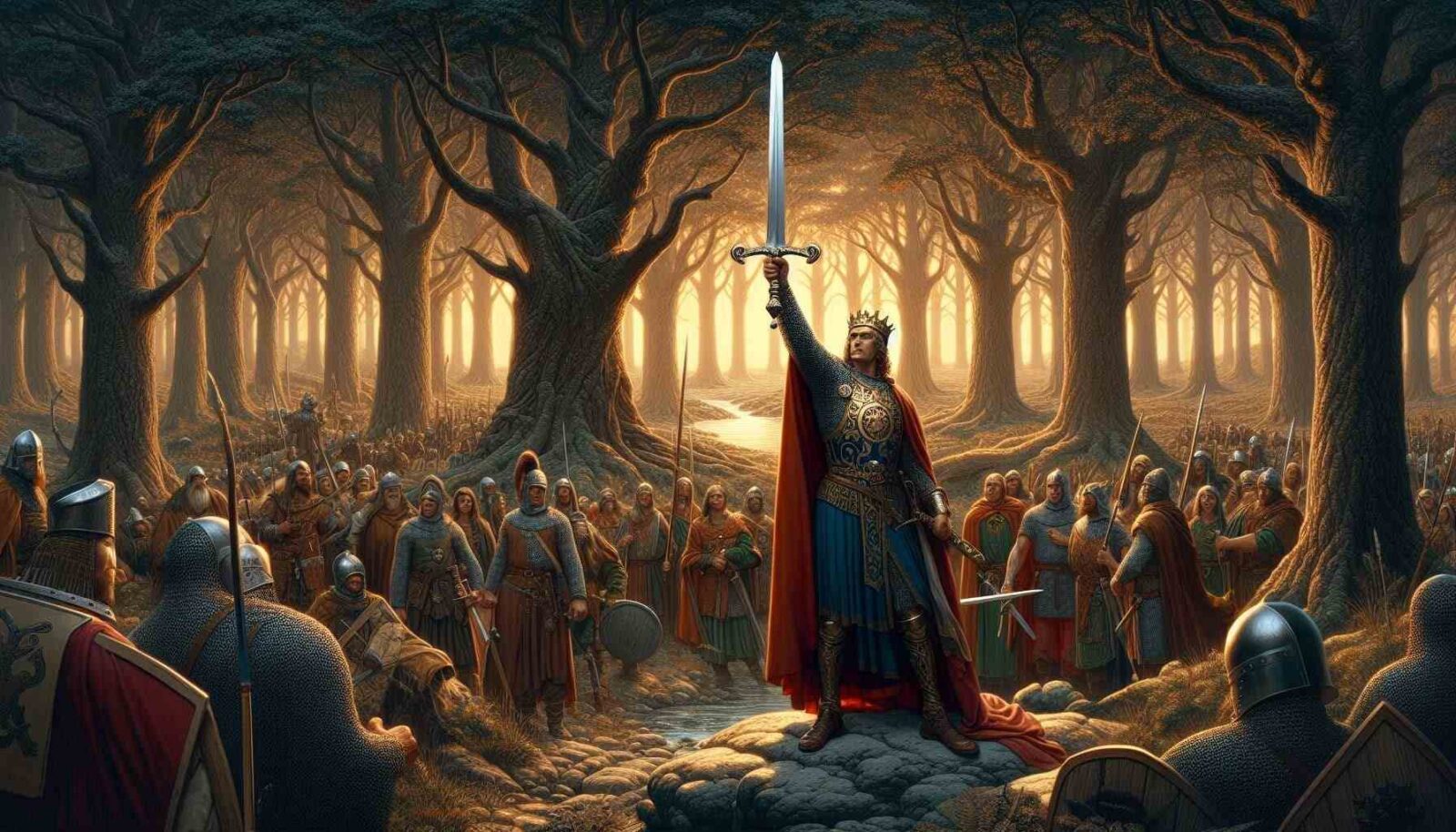
Since time immemorial, magical swords have captivated the imagination of humanity. From the myths and legends of ancient civilizations to the pages of epic fantasy novels, these mystical blades have held sway over the collective consciousness, embodying power, honor, and destiny. Through their enchantments and histories, magical swords transcend mere weapons, becoming symbols of heroism, justice, and the eternal struggle between good and evil.
Origins and Mythological Roots:
The genesis of magical swords lies shrouded in the mists of mythology and folklore. Across cultures and civilizations, tales abound of divine blades forged by gods or gifted to mortals by supernatural beings. In Norse mythology, the mighty sword Gram, wielded by the hero Sigurd, was said to have been crafted by the dwarven smith Regin and used to slay the dragon Fafnir. Meanwhile, the Japanese legend of Kusanagi-no-Tsurugi recounts the retrieval of a sacred sword from the body of a slain serpent, symbolizing imperial authority and protection.
In Arthurian legend, Excalibur, the legendary sword of King Arthur, is perhaps the most iconic example of a magical blade. Bestowed upon Arthur by the Lady of the Lake, Excalibur symbolizes the rightful sovereignty of the king and is said to possess supernatural properties, including the ability to bestow invincibility upon its wielder.
Types of Magical Swords:
Magical swords come in a variety of forms, each imbued with unique enchantments and powers. Among the most common types are:
- Elemental Swords: These blades are infused with the power of the elements, such as fire, ice, lightning, or wind. They can unleash devastating elemental attacks and are often associated with the mastery of natural forces.
- Enchanted Blades: Enchanted swords are imbued with mystical energies that enhance their strength, sharpness, and durability. They may also possess the ability to deflect magic or protect their wielder from harm.
- Cursed Swords: Cursed swords are powerful yet malevolent weapons that exact a price upon their wielders. Often forged through dark rituals or imbued with the essence of evil, these blades can corrupt the souls of those who dare to wield them, driving them towards madness or destruction.
- Sentient Swords: Some magical swords possess sentience and intelligence, communicating with their wielders and guiding them on their quests. These sentient blades often have their own personalities and agendas, forging a unique bond with their chosen champions.
The annals of history and literature abound with tales of legendary swords and the heroes who wield them. In J.R.R. Tolkien’s “The Lord of the Rings,” the sword Sting, wielded by Frodo Baggins, glows blue in the presence of orcs and goblins, serving as a beacon of hope in the darkest of times. Similarly, the sword Glamdring, borne by Gandalf the Grey, is a relic of the ancient kingdom of Gondolin, radiating with the light of elven magic. In the Arthurian legends, the Sword in the Stone represents the test of Arthur’s rightful claim to the throne of Camelot. Only the true king of Britain, destined to unite the land and rule with justice, can draw the sword from its enchanted resting place.
Modern Interpretations:
In contemporary fantasy literature and media, magical swords continue to hold a prominent place in the collective imagination. From the legendary sword of Gryffindor in J.K. Rowling’s “Harry Potter” series to the iconic Lightsaber wielded by Jedi knights in the “Star Wars” saga, these enchanted blades inspire awe and wonder, transcending the boundaries of reality and fiction.
Video games such as “The Legend of Zelda” series feature legendary swords like the Master Sword, a weapon of unparalleled power wielded by the hero Link in his quest to save the kingdom of Hyrule from the forces of darkness. With its iconic design and storied history, the Master Sword has become an enduring symbol of courage and heroism in gaming culture.
Conclusion:
Magical swords occupy a special place in the pantheon of myth and legend, embodying the timeless themes of heroism, destiny, and the eternal struggle between light and darkness. From the ancient myths of gods and heroes to the realms of modern fantasy literature and media, these enchanted blades continue to capture the imagination of audiences around the world, serving as symbols of power, honor, and the triumph of the human spirit. As long as stories are told and adventures undertaken, the mystique of magical swords will endure, inspiring generations to dream of epic quests and noble deeds.
Unveiling the Legend: The Excalibur, Sword of King Arthur
In the annals of myth and legend, few tales captivate the imagination as fiercely as the saga of King Arthur and his legendary sword, Excalibur. Throughout centuries of storytelling, the Excalibur has emerged as a symbol of heroism, justice, and the pursuit of noble ideals. From its mysterious origins to its pivotal role in Arthurian lore, the Excalibur continues to wield an enchanting allure that transcends time and culture.
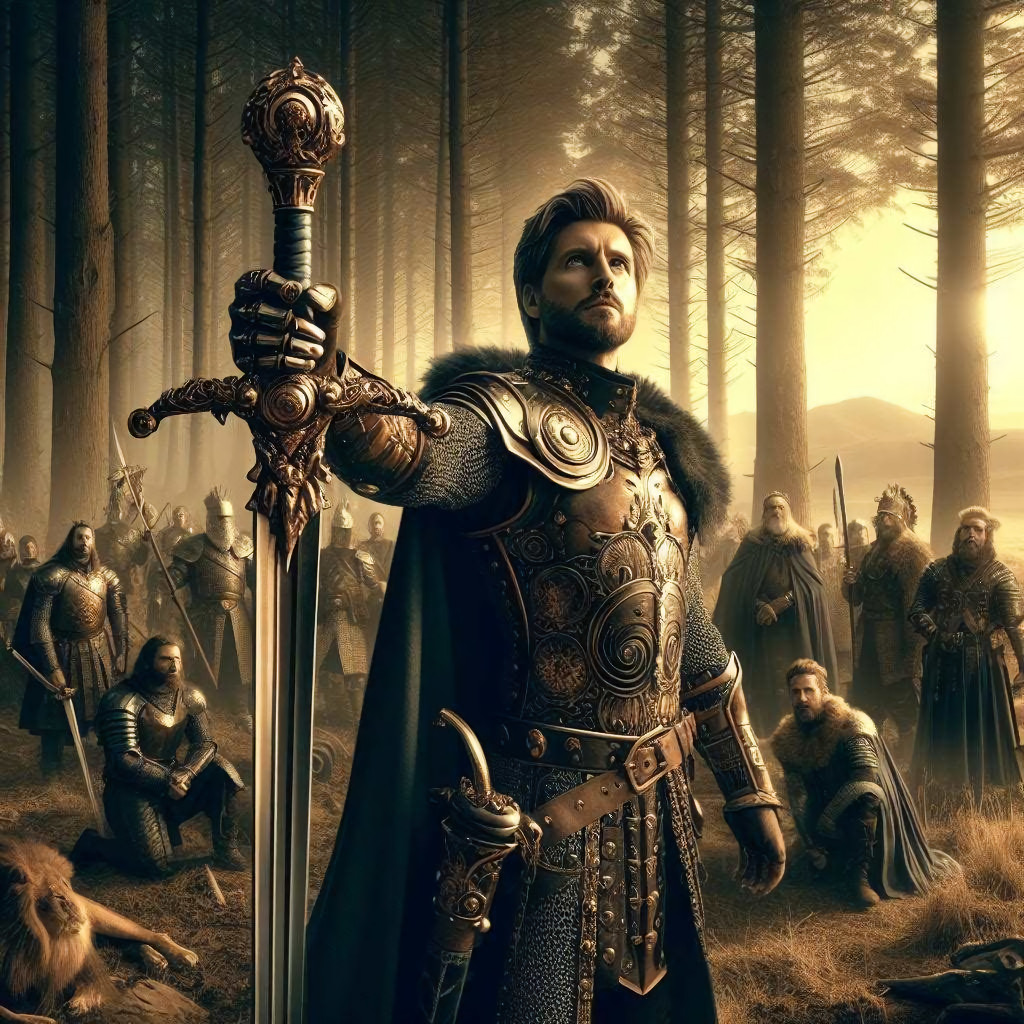
Origins and Mythical Significance
The origins of Excalibur are shrouded in mystery, weaving through the fabric of Celtic and medieval literature. In the earliest Welsh tales, Arthur wields a sword named Caladfwlch, which translates to “hard cleft” or “cutting steel.” This blade, often associated with his early adventures, bears resemblances to the Excalibur of later narratives. However, it was the French author Chrétien de Troyes who, in the 12th century, first introduced the world to Excalibur in his epic poem “Perceval, the Story of the Grail.” De Troyes described the sword as forged on the mystical Isle of Avalon and wielded by the youthful Arthur as he pulled it from a stone, signifying his divine right to rule as king.
Excalibur’s significance extends beyond its physical attributes; it embodies the concept of kingship, legitimacy, and the ideals of chivalry. Its association with Avalon, a realm steeped in magic and mystery, imbues the sword with supernatural qualities, making it more than just a weapon but a symbol of destiny and honor.
The Sword in Arthurian Legend
Throughout the vast tapestry of Arthurian legend, Excalibur remains a central motif, appearing in various retellings, adaptations, and interpretations. In the medieval romance “Le Morte d’Arthur” by Sir Thomas Malory, Excalibur emerges as a symbol of Arthur’s divine mandate and his duty to uphold justice and protect his realm. According to Malory, Excalibur is not merely a weapon but a conduit of Arthur’s authority, granted to him by the Lady of the Lake, an otherworldly figure who bestows the sword upon the king. The blade, with its shimmering edge and radiant aura, becomes an emblem of Arthur’s sovereignty and his role as the guardian of Camelot.
The iconic imagery of Excalibur often intertwines with pivotal moments in Arthurian lore, including the fabled Sword in the Stone contest, where only the rightful king can withdraw the blade from its rocky sheath. Arthur’s triumph in this legendary feat solidifies his claim to the throne and establishes Excalibur as a symbol of divine providence and righteousness.
Symbolism and Themes
Beyond its role as a weapon of war, Excalibur embodies a myriad of symbolic meanings and thematic elements within Arthurian literature. The sword represents the virtues of courage, honor, and integrity, qualities that define the noble knight and the ideal ruler. In the hands of Arthur and his knights of the Round Table, Excalibur becomes a symbol of unity and camaraderie, forging bonds of brotherhood and loyalty that endure through hardship and adversity.
Moreover, Excalibur embodies the concept of moral agency and the weight of responsibility that accompanies power. Arthur’s ability to wield the sword with righteousness reflects his commitment to justice and his role as a champion of the oppressed. Conversely, the misuse or mishandling of Excalibur symbolizes the corruption of authority and the descent into chaos and tyranny, as exemplified by Arthur’s nemesis, Mordred. The legend of Excalibur also explores themes of destiny and sacrifice, as Arthur grapples with his predetermined fate and the sacrifices required to fulfill his divine mission. The sword becomes both a tool of destiny and a burden of responsibility, as Arthur navigates the complexities of kingship and the challenges of his tumultuous reign.
Legacy and Cultural Impact
The legacy of Excalibur extends far beyond the realm of literature, permeating popular culture, art, and collective consciousness. From paintings and sculptures to films and television series, the iconic imagery of Arthur drawing the sword from the stone has become an enduring symbol of heroism and triumph over adversity. Countless adaptations and reinterpretations of the Arthurian legend continue to breathe new life into the mythos of Excalibur, offering fresh perspectives on its significance and relevance in contemporary society. Whether portrayed as a relic of antiquity or a symbol of timeless ideals, Excalibur continues to inspire and captivate audiences around the world.
In conclusion, the legend of Excalibur stands as a testament to the enduring power of myth and the timeless appeal of heroic storytelling. Through its mystical origins, symbolic significance, and cultural resonance, Excalibur continues to reign supreme as one of the most iconic symbols of Arthurian legend, embodying the timeless virtues of courage, honor, and the pursuit of noble ideals. As long as the tale of King Arthur endures, so too shall the legend of Excalibur, a sword forged in the fires of myth and tempered in the crucible of legend.
The Legend of Gram: Sigurd’s Sword of Destiny Against Fafnir the Dragon
In the rich tapestry of Norse mythology, few tales captivate the imagination as fiercely as the saga of Sigurd the Dragonslayer and his mighty sword, Gram. The epic confrontation between Sigurd and Fafnir, the fearsome dragon, has been etched into the annals of history, stirring the hearts of generations with its valor, intrigue, and mystique.
Origins of Gram:
Gram, the legendary sword wielded by Sigurd, has its roots intertwined with the fate of the Völsung lineage. Crafted by the hands of the dwarf-smith Regin, Gram was forged from the remnants of a divine sword shattered by Odin, the Allfather, in a time long forgotten. This mighty weapon possessed an otherworldly strength, imbued with the power to cleave through any obstacle that dared to stand in its path.
Sigurd’s Quest:
The tale of Gram unfolds against the backdrop of Sigurd’s noble quest for vengeance and glory. Driven by destiny and the desire to avenge his father’s death, Sigurd embarks on a perilous journey, guided by the counsel of Odin himself. His path leads him through treacherous landscapes, where he encounters mythical beings, forges alliances, and confronts insurmountable challenges.
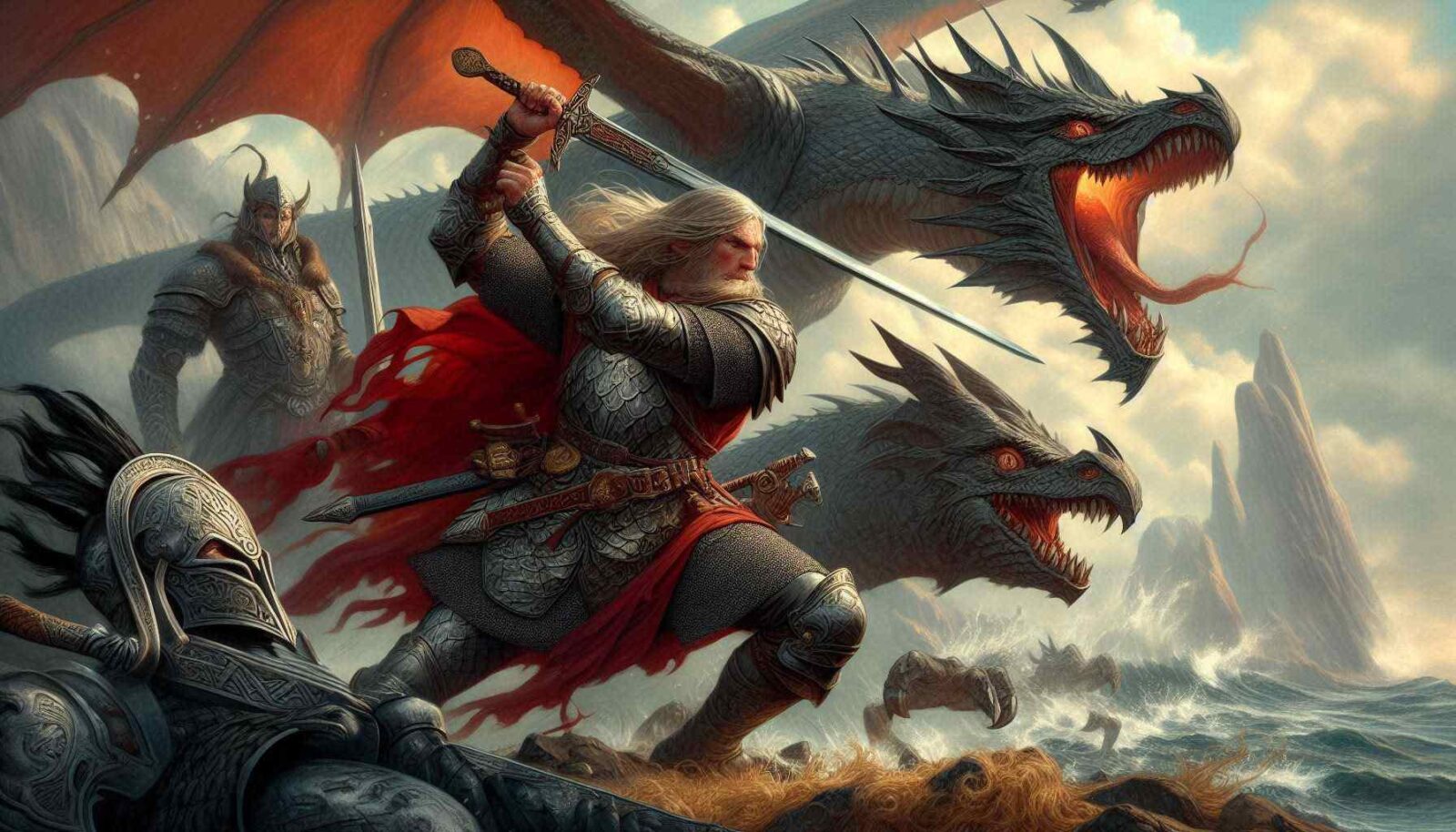
Encounter with Fafnir:
Central to Sigurd’s odyssey is his fateful encounter with Fafnir, the monstrous dragon cursed by greed and betrayal. Transformed by the curse of the cursed ring Andvaranaut, Fafnir’s insatiable lust for gold had twisted his once noble form into a fearsome beast, guarding a vast hoard of treasure with unrelenting ferocity.
The Fateful Battle:
Armed with Gram, Sigurd confronts the dragon in a clash of titanic proportions. The air crackles with tension as steel meets scales, and fire clashes with valor. With each swing of Gram, Sigurd unleashes the full might of his resolve, channeling the courage of his ancestors into every strike.
The Triumph of Sigurd:
In a moment of divine intervention, Sigurd finds a chink in Fafnir’s impenetrable armor, piercing the dragon’s heart with the lethal precision of Gram. As Fafnir’s mighty roar echoes through the mountains, his lifeblood mingles with the earth, sealing his fate and fulfilling the prophecy of his downfall.
Legacy of Gram:
With Fafnir vanquished and his hoard reclaimed, Sigurd emerges victorious, his name etched in the annals of legend alongside the mighty sword, Gram. Yet, the legacy of Gram extends far beyond the realm of mortal reckoning, resonating through the ages as a symbol of courage, justice, and the indomitable spirit of heroism.
Conclusion:
The saga of Gram and Sigurd stands as a testament to the enduring power of myth and the timeless allure of heroism. In the heart of every adventurer, the legend of the Dragonslayer and his mighty sword continues to burn brightly, a beacon of hope amidst the shadows of uncertainty. As long as tales are told and songs are sung, the legacy of Gram shall endure, inspiring generations to heed the call of destiny and carve their own path through the tapestry of time.
Title: Unveiling the Mystique: The Legend of Kusanagi-no-Tsurugi, Japan’s Mythical Sword
In the rich tapestry of Japanese mythology, few legends hold as much allure and mystique as that of the Kusanagi-no-Tsurugi, the legendary sword of the Imperial Regalia of Japan. Often depicted as one of the three sacred treasures of Japan, alongside the Yata no Kagami (the Sacred Mirror) and the Yasakani no Magatama (the Sacred Jewel), the sword of Kusanagi holds a revered place in Japanese folklore, weaving together history, myth, and the essence of the divine.
Origin Story:
The origins of the Kusanagi-no-Tsurugi trace back to ancient Japan, where myths intertwine with the annals of history. According to legend, the sword was originally discovered within the body of an eight-headed serpent, Yamata no Orochi, by the heroic warrior god, Susanoo-no-Mikoto. Susanoo, the younger brother of the sun goddess Amaterasu, encountered the fearsome beast terrorizing the land of Izumo.
In a tale of cunning and bravery, Susanoo slayed the monstrous serpent and found the divine sword, Kusanagi-no-Tsurugi, nestled within one of its tails. The sword, said to possess unparalleled power and craftsmanship, became a symbol of authority and protection, embodying the spirit of valor and righteousness.
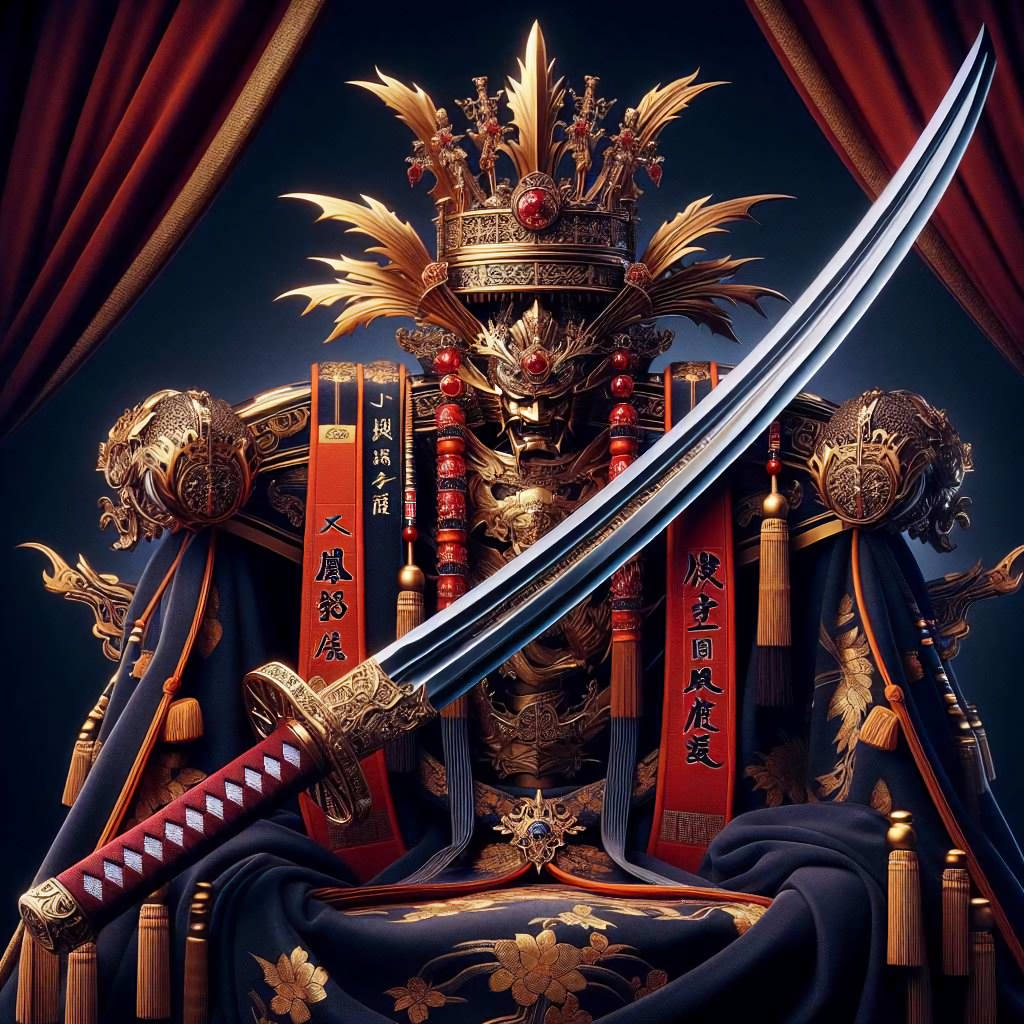
Symbolism and Significance:
The significance of the Kusanagi-no-Tsurugi extends beyond its physical form. It symbolizes the divine right to rule and protect Japan’s imperial lineage, embodying the essence of imperial authority and the connection between earthly rulers and the heavenly realm. Throughout Japan’s history, the sword has been revered as a symbol of legitimacy and sovereignty, its presence essential in significant ceremonies and rituals, including the ascension of emperors.
Moreover, the sword’s association with the mythological realm underscores its mystical properties. Legend holds that the sword possesses supernatural abilities, capable of controlling the forces of nature and influencing the course of destiny. Its presence in historical accounts and folklore reflects the enduring belief in the power of divine artifacts and their role in shaping the fate of nations.
Historical Significance:
While the Kusanagi-no-Tsurugi’s existence remains shrouded in mystery, its influence on Japanese history is undeniable. Historical accounts dating back to the early centuries of Japan’s imperial era mention the sword in tales of heroism and conquest. From the legendary deeds of Emperor Jimmu, Japan’s first emperor, to the tumultuous struggles of successive rulers, the sword’s legacy echoes through the annals of time.
Throughout Japan’s history, the sword has been enshrined and safeguarded within various sanctuaries and imperial residences, hidden from public view and protected as a national treasure. Its presence during pivotal moments in Japan’s history, including wars, coronations, and diplomatic ceremonies, underscores its enduring significance as a symbol of Japan’s cultural heritage and spiritual identity.
Cultural Depictions and Legacy:
The legend of the Kusanagi-no-Tsurugi continues to inspire artists, writers, and filmmakers, shaping the cultural landscape of Japan and beyond. From classical literature to contemporary media, the sword’s mythical allure permeates through storytelling and artistic expression, captivating audiences with its tales of heroism and divine intervention.
In Japanese art and literature, the sword is often depicted as a celestial weapon wielded by gods and heroes, its gleaming blade reflecting the radiance of divine power. Paintings, woodblock prints, and theatrical performances pay homage to the sword’s legendary origins, immortalizing its place in Japan’s cultural imagination.
Moreover, the sword’s legacy extends beyond the realm of myth and folklore, serving as a potent symbol of national identity and resilience. In times of adversity and uncertainty, the legend of the Kusanagi-no-Tsurugi reminds the Japanese people of their enduring spirit and the indomitable strength derived from their rich cultural heritage.
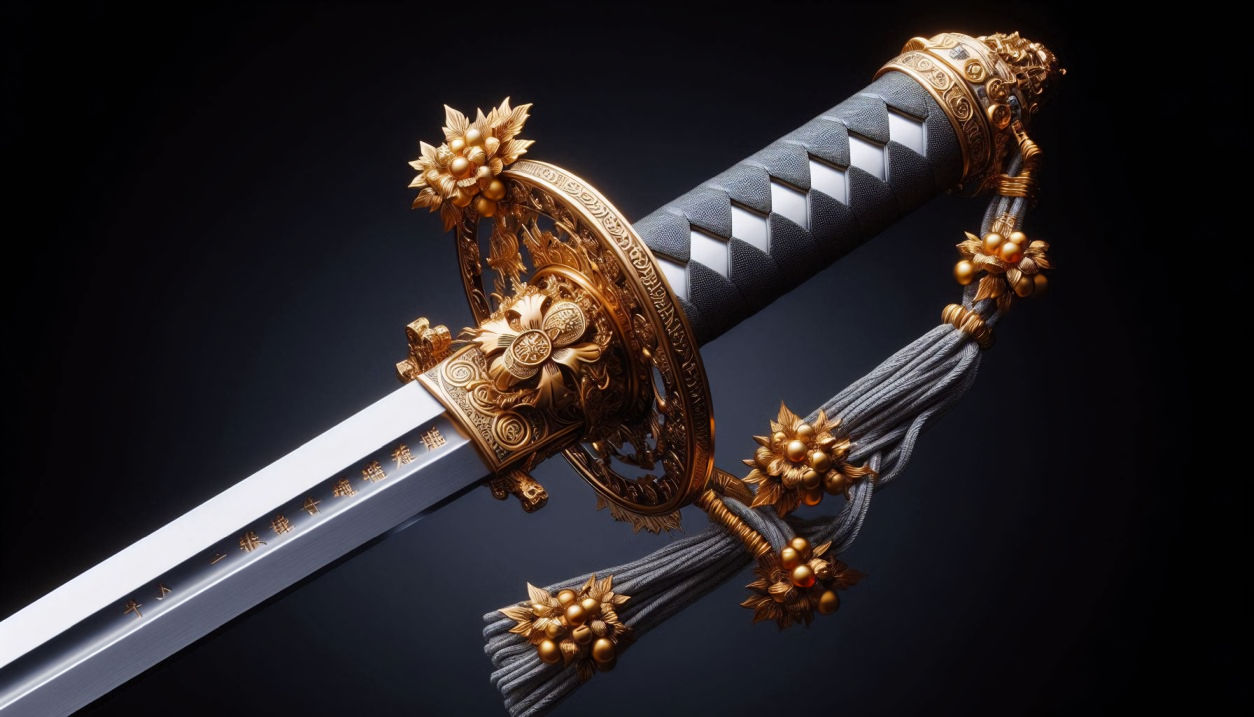
Conclusion:
In the tapestry of Japanese mythology, the legend of the Kusanagi-no-Tsurugi shines as a beacon of courage, wisdom, and divine providence. From its mythical origins within the belly of a serpent to its role as a symbol of imperial authority, the sword embodies the essence of Japan’s spiritual legacy and cultural identity.
As Japan marches forward into the currents of time, the legend of the Kusanagi-no-Tsurugi endures as a testament to the enduring power of myth and the timeless allure of the human imagination. In the hearts and minds of the Japanese people, the sword remains not only a relic of the past but a guiding light illuminating the path towards a future shaped by the echoes of ancient wisdom and the promise of tomorrow.
In the fascinating world of Japanese mythology, few legends hold as much allure and mystique as that of the Kusanagi-no-Tsurugi, the legendary sword of the Imperial Regalia of Japan. Often depicted as one of the three sacred treasures of Japan, alongside the Yata no Kagami (the Sacred Mirror) and the Yasakani no Magatama (the Sacred Jewel), the sword of Kusanagi holds a revered place in Japanese folklore, weaving together history, myth, and the essence of the divine powers.
Unraveling the Mystique: The Magical Swords of the Japanese Samurai
In the annals of history, the samurai of Japan stand as an emblem of honor, loyalty, and martial prowess. Central to their identity were the magnificent swords they wielded, revered not only for their craftsmanship but also for their perceived magical properties. For centuries, the swords of the Japanese samurai have captured the imagination of scholars, warriors, and enthusiasts alike, shrouded in an aura of mystique and legend.
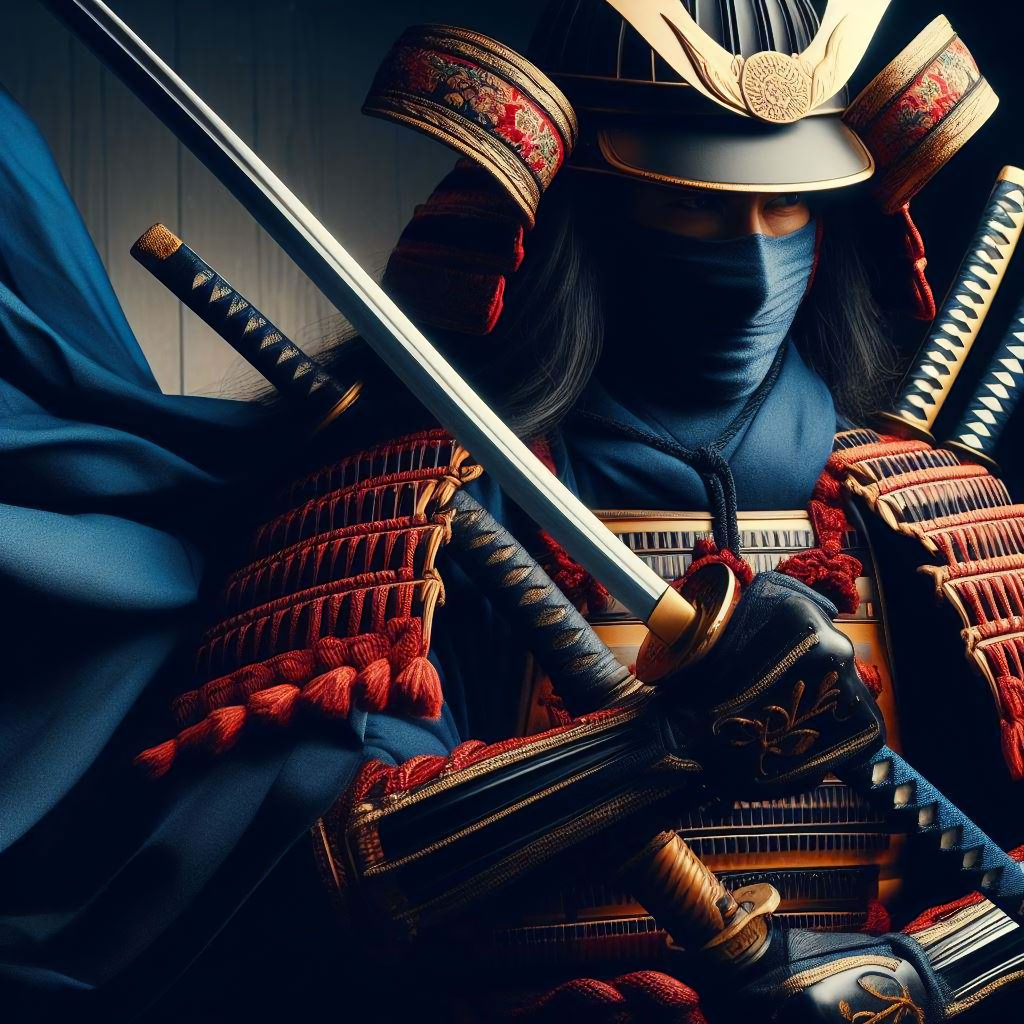
To comprehend the belief in the magical nature of these swords, one must delve into the rich tapestry of Japanese history, culture, and spiritual beliefs. At the heart of this reverence lies the concept of the katana, a symbol of the samurai’s soul, a conduit through which they embodied the principles of Bushido, the way of the warrior. Crafted with meticulous precision by master swordsmiths, the katana was more than a mere weapon; it was a reflection of the samurai’s spirit and a testament to their dedication to their craft. The process of forging a katana was steeped in ritual and tradition, with each stage imbued with spiritual significance.
The raw materials, typically tamahagane steel, were smelted and folded repeatedly, a laborious process that not only removed impurities but also instilled the blade with resilience and strength. Through the skilled hands of the swordsmith, the katana took shape, its form a harmonious balance of function and beauty. But it was not just the physical attributes of the katana that inspired awe; it was the intangible qualities that seemed to elevate it beyond the realm of mere mortal craftsmanship. Legends spoke of swords that possessed a soul of their own, blades that whispered to their wielders, guiding them in battle and bestowing upon them divine favor.
One of the most enduring beliefs surrounding the katana was its supposed ability to cut through steel effortlessly, a testament to its unparalleled sharpness and supernatural power. Tales abound of samurai slicing through armor, helmets, and even rival swords with a single stroke, their blades moving with preternatural speed and precision. Part of the allure of the katana lay in its mystical origins. According to legend, the finest blades were forged from metal salvaged from fallen meteorites, imbuing them with celestial energy and otherworldly properties. These “heavenly swords” were said to possess a special connection to the divine, granting their wielders unmatched skill and fortune in battle.
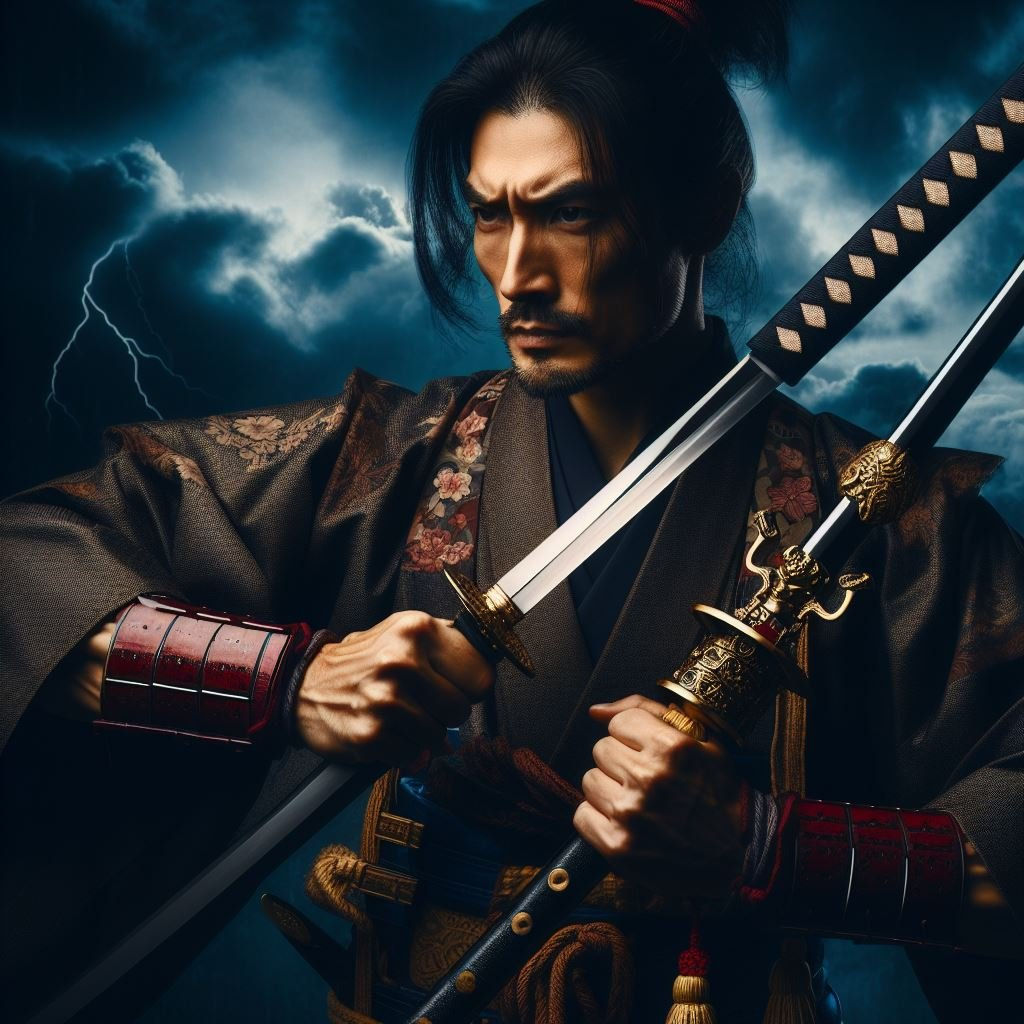
Furthermore, the katana was not merely a tool of war but a symbol of status and prestige. In feudal Japan, where the samurai ruled as the warrior elite, the possession of a finely crafted sword was a mark of nobility and honor. Samurai would spend fortunes commissioning renowned swordsmiths to create bespoke blades that reflected their personality and lineage. The spiritual significance of the katana extended beyond its physical form. Many believed that the sword housed the spirit of its creator, as well as the souls of those who had wielded it before. It was not uncommon for samurai to perform rituals and ceremonies to honor their blades, treating them with the reverence due to a living being.
Moreover, the katana was steeped in symbolism and mythology, its design adorned with motifs drawn from nature, folklore, and religious iconography. From the graceful curve of the blade to the intricate patterns of the hamon, every aspect of the katana was imbued with meaning, a reflection of the samurai’s connection to the natural world and the divine.
The mystique surrounding the katana persists to this day, captivating the imagination of historians, collectors, and martial artists around the world. Despite the passage of centuries, the allure of the samurai sword endures, a testament to its enduring legacy and timeless appeal.
In conclusion, the belief in the magical properties of the Japanese samurai sword, particularly the katana, is rooted in a complex interplay of history, culture, and spirituality. As more than just a weapon, the katana represents the embodiment of the samurai’s ideals and values, a symbol of their unwavering commitment to duty, honor, and loyalty. In its craftsmanship and mythology, the katana transcends the realm of the mundane, standing as a testament to the enduring power of human creativity and imagination.


